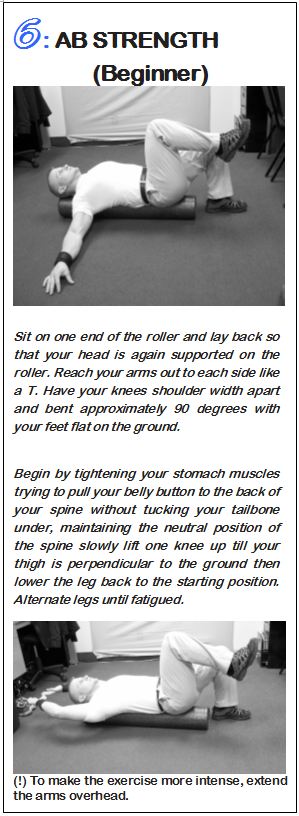Get Rolling!
Written by Richard Tarleton
What is Foam Rolling?
Foam
rolling allows you to do the work of a massage therapist, kneading and working
out tight and sore muscles, speeding recovery and improving balance,
coordination, and flexibility. Athletes
and clinics have been using it successfully for years.
Foam
Rolling works by utilizing your body weight against the roller and gently
"rolling out" with the grain of the muscle from one end to the
other. When properly performed foam
rolling is a self deep tissue massage technique (Called Self-Myofacial
Release) that mobilizes the tissues and stimulates circulation to the area,
helping you recover quicker and keep your muscles flexible. Depending on your goals, foam rolling may
benefit you before and/or after your workouts.
What is a foam roller?
A
foam roller is a piece of extruded foam, much like a swim noodle but
denser. They are commonly 6-inches wide
in diameter and can be between 1 and 3
feet long. There
are some "advanced" rollers that are textured or made of PVC piping,
but they are reserved for those with dense muscle tissue (i.e. athletes).
Rolling Technique is simple.
With
the roller on the ground gently place the end of the muscle you want to work on
it. Slowly start to roll back and forth
with the grain of the muscle. Start with
small short passes at first eventually rolling from one end of the muscle band
to the other.
If
you encounter any knots or hot-spots, back off slowly and gently roll to
"bump" against it until you can make a full pass over it. Each muscle group can be rolled for 30-60
seconds (performing between 10 and 20 full passes) or until it feels relaxed
and mobile.
A
gentle word of caution. At
first, using the Foam roller can be intense—and even painful—as any deep tissue
massage can be. As the tissue becomes
more pliable over time, the pain will diminish.
Avoid putting too much pressure on joints, bony structures, and
tendons. Go easy at first.
Some
exercises focus on balance and muscular coordination rather than
self-massage. With these exercises,
perform each movement slowly and in a controlled manner. The goal is to remained balanced on the
roller. Also, key note: Remember To
Breathe!
Now
that you understand what the goals of rolling are, here is a 10-exercise
starter program for Foam Rolling. Try
each of these exercises before and after your regular workout.
These
10 exercises are the basics of foam rolling.
A personal trainer can help you decide if other exercises will benefit
you and how to get the most out of your workouts.
DISCLAIMER:
These exercises are intended for healthy adults. Perform these exercises at your own
risk. Consult your trainer, physical
therapist, or doctor before starting a new exercise program.
**********
Source: Hughes,
Erin . "Foam Roller Fitness". 2002.












No comments:
Post a Comment